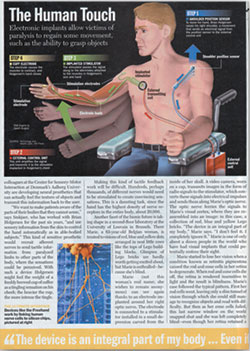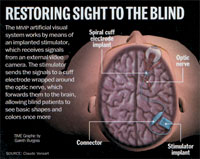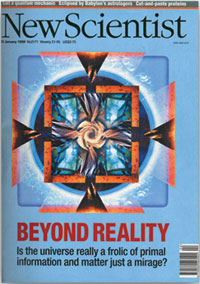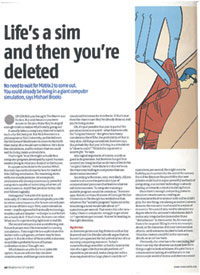 New Scientist is one of the best-known science magazines. Its April 27, 2002 cover story was written by scientist J.R. Minkel, titled "The Hollow Universe." "Why we all live in a hologram" the cover headline reported. To sum up the article, we perceive the world as a single bundle of light. Therefore, it would be a mistake to consider matter as the absolute truth by relying on our perceptions. Admits Minkel:
New Scientist is one of the best-known science magazines. Its April 27, 2002 cover story was written by scientist J.R. Minkel, titled "The Hollow Universe." "Why we all live in a hologram" the cover headline reported. To sum up the article, we perceive the world as a single bundle of light. Therefore, it would be a mistake to consider matter as the absolute truth by relying on our perceptions. Admits Minkel:
You're holding a magazine. It feels solid; it seems to have some kind of independent existence in space. Ditto the objects around you—perhaps a cup of coffee, a computer. They all seem real and [as if we are dealing with the original] out there somewhere. But it's all an illusion.
Minkel's article states that some scientists call this idea the "theory of everything," and that scientists consider this theory the first step towards explaining the nature of the universe. This magazine article explains scientifically that we perceive the universe as an illusion in our brains and that, therefore, we are not interacting with matter itself.
 |
|---|
The New Scientist's April 27, 2002 issue with its cover story, "Hollow Universe" and headline, "Why we all live in a hologram." |
With their newly developed systems, researchers in the USA, Europe and Japan aimed to give sight to the blind and help paralyzed patients recover. They have already achieved partial success with this new system by planting electrodes into the relevant areas of the body, and silicon chips were used to connect artificial limbs with living tissue.
Following an accident, a Danish patient by the name of Brian Holgersen was paralyzed from the neck down, except for very limited movement in his shoulders, left arm and left hand. As is known, such paralysis is caused by damage to the spinal cord in the neck and back. The nerves are damaged or blocked, disabling neural traffic between brain and muscles, and cutting off communication between the nerves that transmit signals back and forth from the body to the brain. With this patient, the aim was to bridge his spinal cord's damaged area with an implant, letting signals from the brain bring back a little movement to the arms and legs.
 |
|---|
"The Body Electric," an article in Time magazine's March 11, 2002 issue, contained evidence proving that we cannot reach the actual matter existing outside our mind and that the external world is a copied image in our mind. |
They used a system designed to recover basic functions of the left hand, like grasping, holding and releasing objects. In an operation, eight small coin-sized flexible cuff electrodes were implanted into the muscles responsible for those movements in the patient's upper left arm, forearm and shoulder. Later, ultrathin wires connected these electrodes to a stimulator—a kind of pacemaker for the nervous system— implanted in his chest. The stimulator was in turn linked to a position-sensing unit attached to Holgersen's right shoulder—over which he retains some motor control.
Now, when the patient wants to pick up a glass, he moves his right shoulder upward. This movement sends an electrical signal from the position sensor, worn under his clothing, to the stimulator in his chest, which amplifies it and passes it along to appropriate muscles in his arm and hand. They contract in response, and his left hand closes. When he wants to release the glass, he moves his right shoulder downward, and his left hand opens. |
|---|
According to the same issue of Time magazine, experiments in artificial visual systems revealed that blind people can regain partial sight with artificially generated signals without the need for their eyes—or any external object to see. |
In this patient's case, the electrode was connected to a stimulator placed inside a cavity in the skull. A video camera, worn on a cap, transmitted the images to the stimulator in the form of radio signals, bypassing the damaged rod and cone cells, and delivered the electric signals directly to the optic nerve. The brain's visual cortex reassembled these signals to form an image. The patient's experience is comparable to watching a miniature stadium billboard, but the quality is nevertheless sufficient to prove that this system is viable.
 |
|---|
Discoveries of modern physics show that we merely know the physical universe as it appears in our minds is the sum total of our perceptions. The renowned English journal New Scientist, investigated this subject in its January 30, 1999 cover story, "Beyond Reality." |
This system is called a "Microsystem-based Visual Prosthesis," a device permanently implanted into the patient's head. But to make it all work, the patient needs to go to a specially designated room in the University of Louvain and wear what looks like a badly damaged bathing cap. The bathing cap is made of plastic with a standard video camera installed on its front. The more pixels there are to form an image on the screen, the greater the number of electrical stimulations; therefore, the greater the resolution quality of the image.
 |
|---|
The July 27, 2002 issue of New Scientist suggested the possibility of us living in an artificially created world in an article titled: "Life's a sim and then you're deleted." |
These technologies, provided that they can be sufficiently reduced in size and placed inside the body, will pave the way for radically new developments in medicine. These developments demonstrate another important fact: We never deal with the actual external world and everything is a copied image that we watch in our minds…
The Time article showed practical examples of how we can create perceptions like sight or touch by artificially created impulses. The most obvious proof is that a blind person was able to see. Despite the patient's eye not being functional, she could see by means of artificially created signals.
Author Brooks supports his views by quoting philosopher Nick Bostrom of Yale University, who believes that Hollywood movies come much closer to reality than we realize. He calculates, too, that there is some probability that we are living in a simulated or virtual world as some movies depict.
The scientific fact, much better understood in recent years, that we are not interacting with matter itself, causes people to reflect more deeply. This situation, the frequent inspiration for movies, points out that virtual environments recreate reality so realistically that people can be fooled by these illusionary images.
What! Are they in doubt about the meeting with their Lord?What! Does He not encompass all things? |
|---|
|